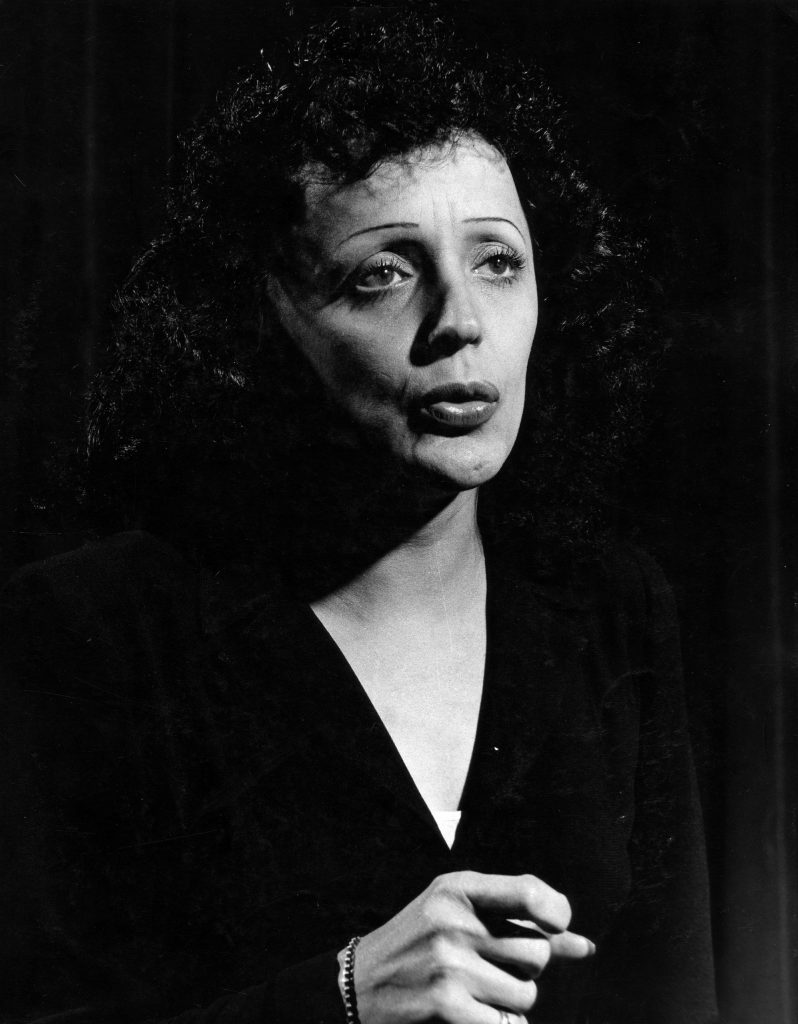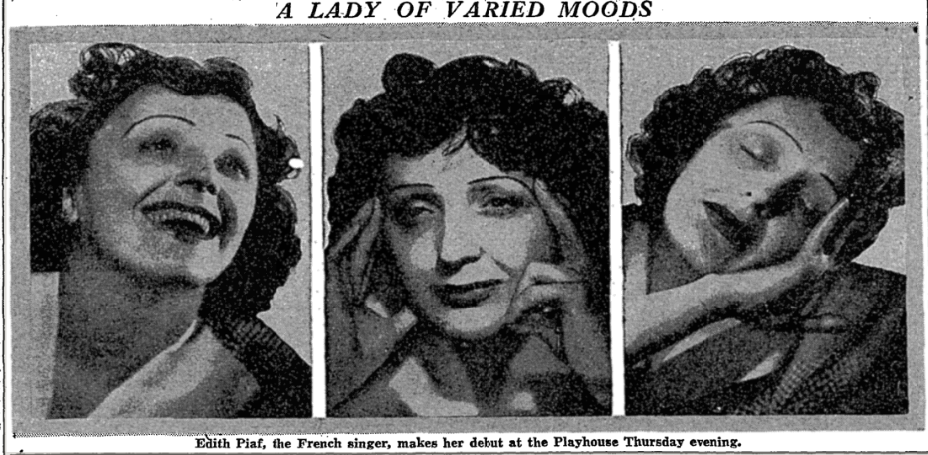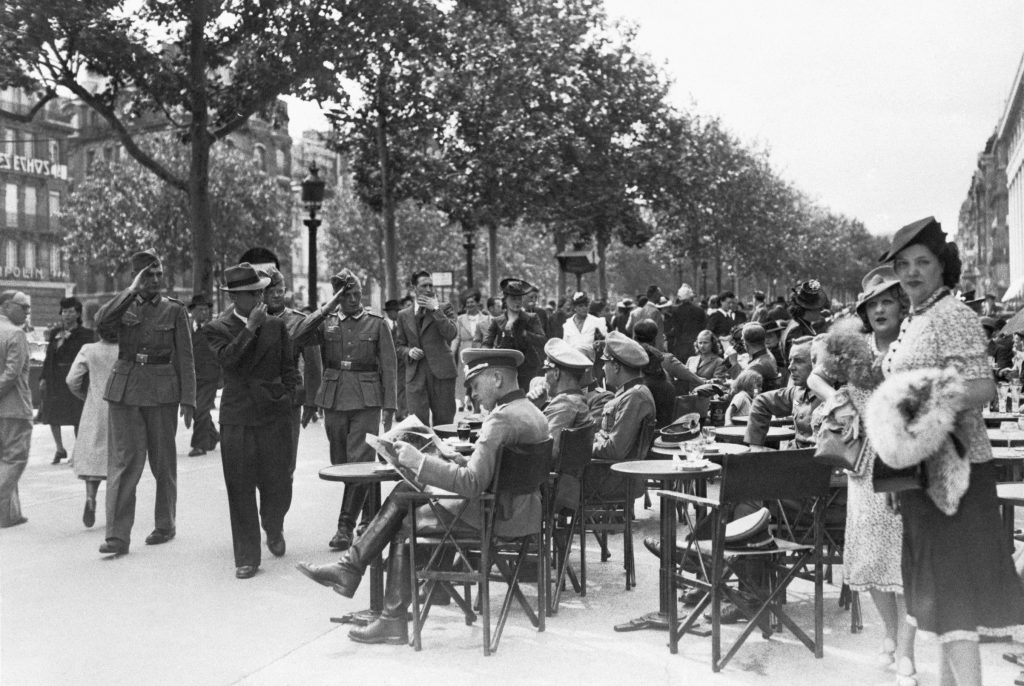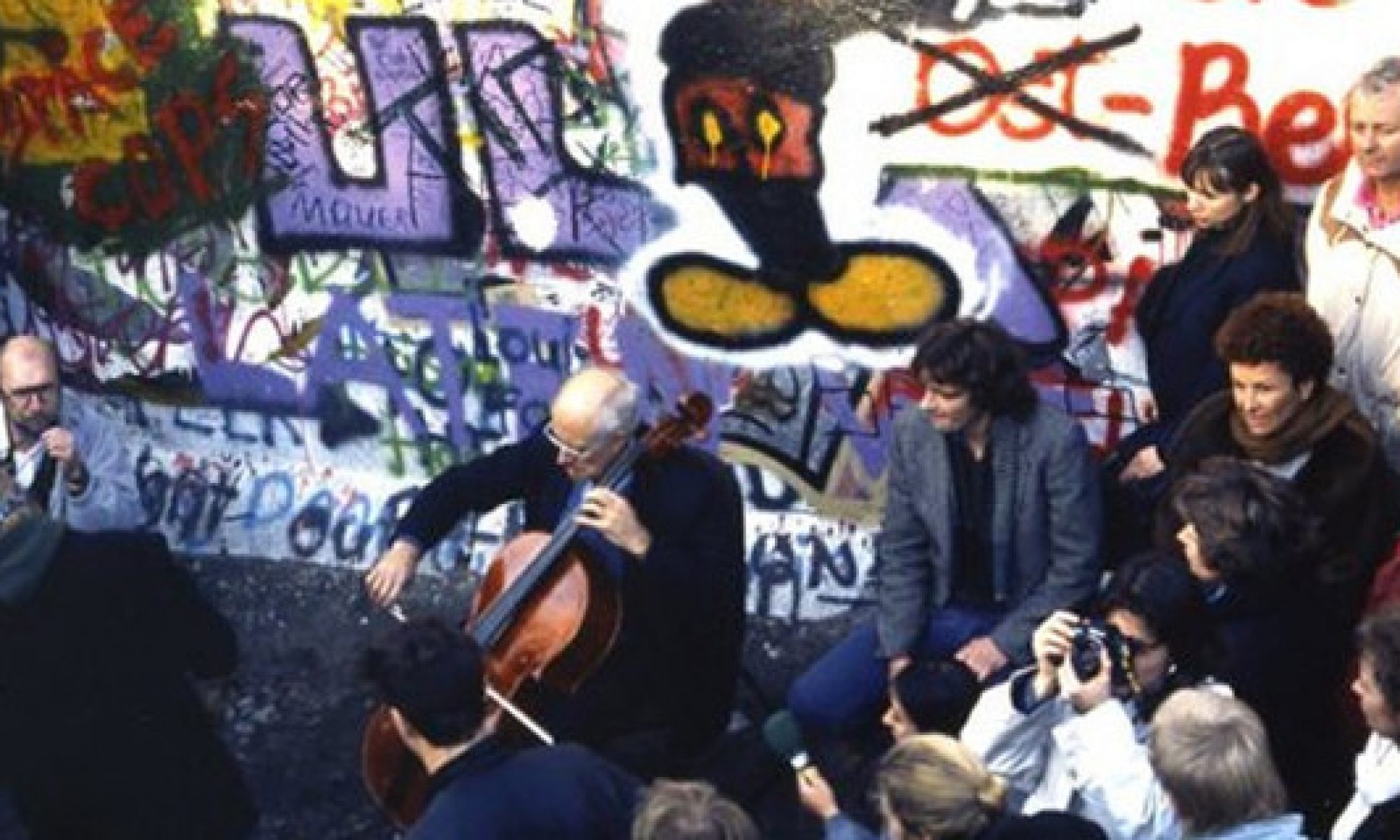
Berman, Eliza. “See the Many Faces of Edith Piaf.” Time.com. https://time.com/4140355/edith-piaf-centennial/
Born on December 19, 1915, Edith Piaf’s life has been described as “a condensed narrative of France’s twentieth-century emergence from vestigial traditionalism to triumphant modernity, from the Third Republic to the Fifth…” [I]. With two policemen reportedly assisting in the delivery on the sidewalk, Piaf was later given to a grandmother. Her early life was filled with highs and lows, from having meningitis and losing her eyesight to regaining it miraculously when visiting the shrine of Sainte Thérèse de Lisieux. This unconventional life only continued, from touring with her father, a traveling acrobat, for several years lacking any semblance of a normal family life or school, to her young romance with a soldier resulting in her having a child who died in infancy and a love who was transferred away. Yet, all of a sudden, she was discovered where she was known to sing on the sidewalks [II]. Despite newspapers trying to link her to her benefactor’s murder, Edith Piaf was then off to a successful career, from beginning in a nightclub to Paris’ largest theaters and concert halls to touring around Europe [III]. However, Piaf owes much of this success due to her performances during wartime. Just as the guilt or innocence of composers in Germany during the Nazi era was debated, Piaf’s complacency in the matter leaves her place in history to be determined.
| Des yeux qui font baisser les miens | A gaze that make me lower my own |
| Un rire qui se perd sur sa bouche | A laugh that is lost on his lips – |
| Voila le portrait sans retouches | That is the un-retouched portrait |
| De l’homme auquel j’appartiens | Of the man to whom I belong |
| Quand il me prend dans ses bras | When he takes me into his arms |
| Il me parle l’a tout bas | He speaks to me softly |
| Je vois la vie en rose | And I see life through rose-colored glasses |
| Il me dit des mots d’amour | He speaks words of love to me |
| Des mots de tous les jours | They are every day words |
| Et ça m’ fait quelque chose | And they do something to me |
| Il est entré dans mon coeur | He has entered into my heart |
| Une part de bonheur | A bit of happiness |
| Dont je connais la cause | That I know the cause of |
| C’est lui pour moi | It’s only him for me |
| Moi pour lui dans la vie | And me for him, for life |
| Il me l’a dit, l’a jure pour la vie | He told me, he swore to me, for life |
| Et, dès que je l’aperçois | As soon as I notice him |
| Alors je sens en moi | I feel inside me |
| Mon coeur qui bat | My heart beating |
| Des nuits d’amour à plus en finir | Endless nights of love |
| Un grand bonheur qui prend sa place | Bring great happiness |
| Les ennuis, les chagrins, s’effacent | The pain and bothers fade away |
| Heureux, heureux à mourir | Happy, so happy I could die |
| Quand il me prend dans ses bras | When he takes me into his arms |
| Il me parle tout bas | He speaks to me softly |
| Je vois la vie en rose | And I see life through rose-colored glasses |
| Il me dit des mots d’amour | He speaks words of love to me |
| Des mots de tout les jours | They are every day words |
| Et ça m’ fait quelque chose | And they do something to me |
| Il est entré dans mon coeur | He has entered into my heart |
| Une part de bonheur | A bit of happiness |
| Dont je connais la cause | That I know the cause of |
| C’est lui pour moi | It’s only him for me |
| Moi pour lui dans la vie | And me for him, for life |
| Il me l’a dit, l’a jure pour la vie | He told me, he swore to me, for life |
| Et, dès que je l’apercois | As soon as I notice him |
| Alors je sens en moi | I feel inside me |
| Mon coeur qui bat | My heart beating |
| Lalalala, lalalala | Lalalala, lalalala |
| La, la, la, la | La, la, la, la |
Darby, “La Vie en Rose Lyrics and English Translation – Edith Piaf [Original Version]. FrenchLyricsTranslations.com. https://www.frenchlyricstranslations.com/la-vie-en-rose-edith-piaf-french-lyrics-and-english-translation/ (accessed October 14, 2019).

Bernstein, Lester. “The Perils of Piaf.” The New York Times. October 26, 1947.
When World War II broke out, Edith Piaf’s career was just beginning. France had already suffered massive casualties in World War I, and thus intended to remain on the defensive at the onset of World War II. However, following Hitler’s attacks, France collapsed, leaving France wounded from Hitler’s attacks and open to many more from the Allies during the Vichy regime [IV]. Because France was occupied and annexed by Germany, the German Propaganda department subsequently controlled all aspects of French entertainment, including Piaf’s music [V]. Despite Piaf’s seeming willfulness to return to her humble beginnings recalling “I loved singing in the streets…Even now, when I think of it, I think that I could do it again very easily,” France’s economy was destroyed after World War I and as an entertainer, Piaf appeared to be determined to do what was necessary to be successful [III]. As such, Piaf registered her music with the German Propaganda department and had her song lyrics vetted. Due to approval from the Nazis, Piaf was able to perform works that others would not necessarily be able to. From performing wearing the French flag to lyrics stating “I can’t stand Hitler, the Nazis seem to forget that we were the people who slammed them in the war” to assisting in the writing of jazz music, Piaf had freedom as an artist despite the lack of freedom in France under the Nazi regime [V].
In some ways, Piaf utilized this popularity to help those in need. However, these people were often her personal friends. These friends were largely Jewish musicians, such as her partnership with the Jewish musician Michael Emer whom she paid for to allow him into an area of unoccupied France and her Jewish pianist Norbert Glanzberg who was also her lover for some time [V]. Knowing how the Nazi party viewed working with Jewish artists, perhaps Piaf’s actions should not be so easily dismissed. Despite this, Piaf would have been aware of Resistance activities and chose to look the other way, neither aiding nor hindering. This complacency is most apparent in her performances for French prisoners in Germany; while her tour became part of an effort by the resistance to create fake passports allowing prisoners to escape, the tour was also intended to cement her popularity among the Nazis [V].

Ball, David. “Inside the Diary of a Jewish Writer in Nazi-Occupied France.” Time. Accessed October 16, 2019. https://time.com/5261725/vichy-diary-translator/.
Following World War II, La Vie en Rose was written in 1946 filled with lyrics of optimism and hope for the future. This is not only reflective of Piaf’s success out of her own troublesome life, but of France’s growth out of destruction. Most notably in the chorus, Piaf speaks to being held by the person she loves. This person is symbolic of hope, allowing both Piaf and France to see the world in a better way. Looking through rose-colored glasses speaks to France looking past what is evidently there, a country destroyed by the war and Germany’s occupancy, and onto something better. Post-World War II France needed to be taken into the comforting arms of hope and look forward to what things could be, following the death, destruction, and economic loss suffered. Most importantly, a new government had to be established after liberation. These arms of hope may be simply that or may be symbolic of a greater power, such as God. Religion often acts as a beacon of hope for the future. This can be seen in Piaf’s early life, as it is said that her blindness was cured after visiting the shrine of Sainte Thérèse de Lisieux. Just as her belief aided Piaf in her own life, religion is often utilized to heal a nation in its most difficult times and France was in desperate need of this.
Furthermore, Piaf continued detailing her lover speaking to her in “everyday words and they do something to me.” Similarly to Piaf’s lyrics, what France needed was a return to normality. This idea of normalcy is often difficult to pinpoint, but the notion of having a conversation that would have occurred before the war once again would be a sign of a country recovering. These everyday terms are even more meaningful at this point, due to the traumatic events occurred by France and its people during the war. By Piaf finally noticing him and feeling him, France is finally growing out of the war and beginning to see a change. As she refers to this man as the cause of her happiness, it is evident hope is returning both to Piaf’s life and to France as a whole. While the years went on, “the pain and bothers fade away,” as France was slowly rebuilding itself, culminating to Piaf feeling her “heart beating,” as she and France are alive once again. Fading out singing “lalala,” Piaf and France disappear into their hopeful future. While Piaf never directly stated her intent with the song La Vie en Rose, the message of seeing life through rose-colored glasses, or seeing life tinted with joy and optimism, is one that truly raised France’s national spirits from the darkness of World War II leading France to view Edith Piaf as a national treasure today.
- Baxter, Peter. “‘Love Has a History’: France, Film, and Edith Piaf.” Journal of Popular Film and Television 43, no. 4 (February 2015): 212–19. https://doi.org/10.1080/01956051.2015.1043721.
- Bracker, Milton. “Miracle of the ‘Sparrow Kid’.” The New York Times. January 22, 1961.
- Bernstein, Lester. “The Perils of Piaf.” The New York Times. October 26, 1947.
- Sheffield, Dr Gary. “History – World Wars: The Fall of France.” BBC. BBC, March 30, 2011. http://www.bbc.co.uk/history/worldwars/wwtwo/fall_france_01.shtml.
- ORT, World. “Music and the Holocaust.” Music and the Holocaust: Piaf, Edith. Accessed October 15, 2019. http://holocaustmusic.ort.org/resistance-and-exile/french-resistance/edith-piaf/.

